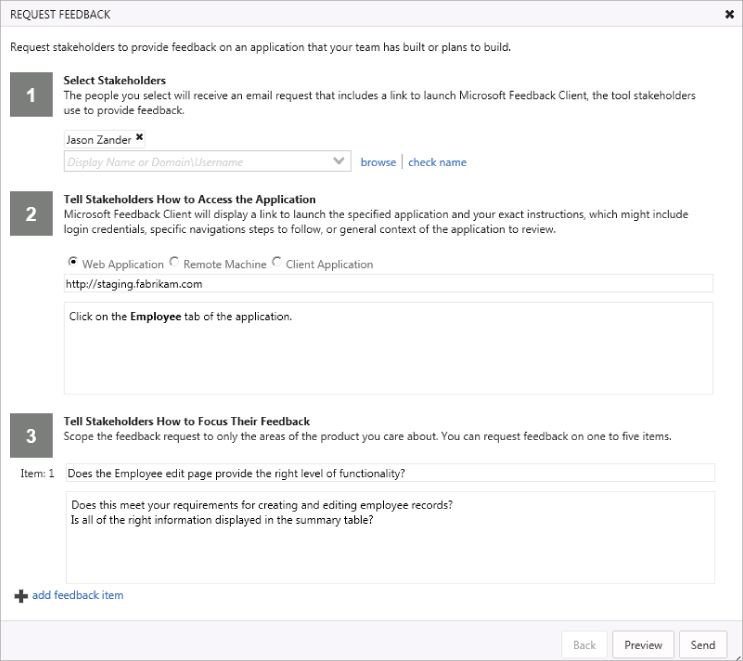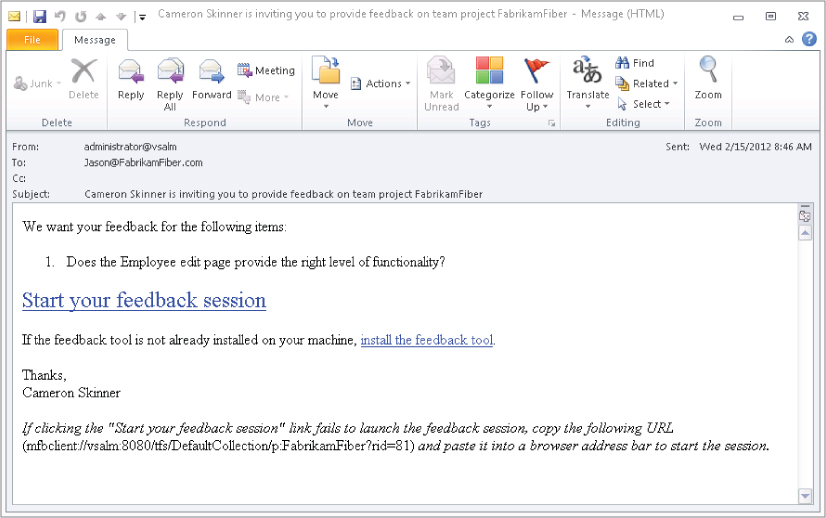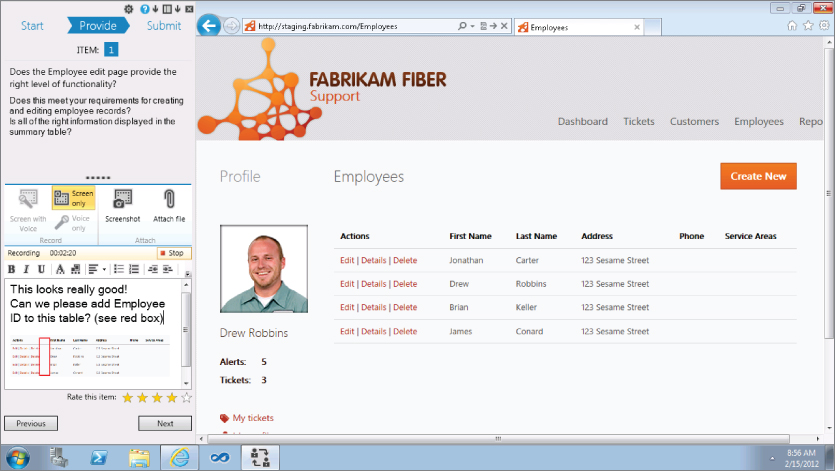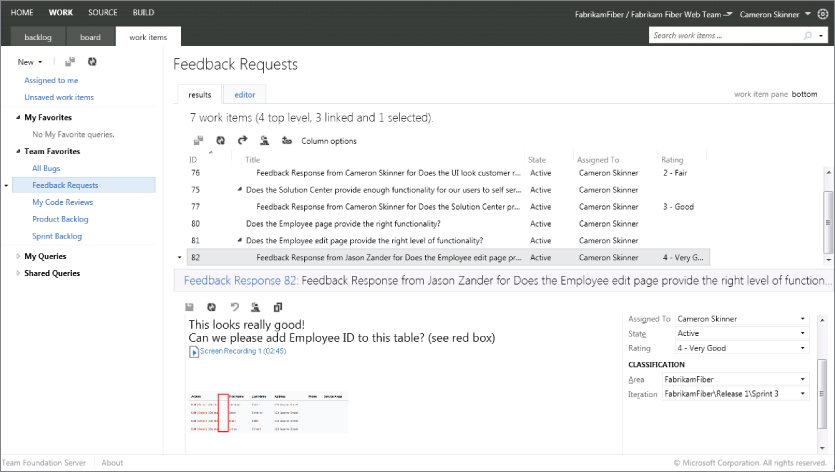Chapter 9
Capturing Stakeholder Feedback
What's in this chapter?
- Discovering how the development team can request feedback from stakeholders on specific features or requirements
- Learning how project stakeholders can use the Microsoft Feedback Client to provide rich feedback about your software
So far in this section you have learned about the importance of engaging with your software development project's stakeholders to ensure that you have a clear understanding of what your stakeholders want you to build before you start implementing it. But regardless of how much time you spend up front during this requirements elicitation phase, the first iteration of software you create is rarely going to meet all of their expectations.
There are a variety of reasons for this. Technical challenges might get in the way of the originally planned implementation; business requirements may evolve from the time when you first capture them to the time that you implement the first working code; the opinions of users can be fickle, and may even be influenced by seeing the software in action for the first time; you may not have truly understood what your stakeholders were asking for when you were capturing their requirements; or you may not have had time to implement all the requirements in the initial release.
These possibilities will be anticipated by any Agile software development team who embraces the fact that software development is something of an art form, requiring iterative cycles of requirements gathering, implementation, and feedback, which in turn informs an additional round of requirements and changes that must be implemented. But the challenge for any team is finding a way to effectively capture feedback from their stakeholders in a manner that can be analyzed, synthesized, and acted upon. This problem is made harder when stakeholders are time-shifted or geography-shifted away from the software development team. But even if the development team shares a common location with their stakeholders, finding a systematic way of gathering feedback from all of their stakeholders on a recurring basis can be a burdensome task.
In this release of Visual Studio 2012, Microsoft has integrated the process of collecting stakeholder feedback directly into their application lifecycle management tooling capabilities. In this chapter you find out how to use this tool to solicit and capture feedback from your stakeholders in a rich, actionable way.
Requesting Feedback
The first step toward getting great feedback from your stakeholders about your software is to properly frame the question of what you are asking for feedback on. The question of whether or not your software provides the right level of functionality is a very different question from whether or not your software is designed properly. Functionally, a tractor can get me from my house to my office in the morning, but it's not what I feel comfortable being seen in as I pull into the parking lot at work. But early on in a software development iteration, the team may be focused squarely on strictly implementing the required functionality with the understanding that they can make it look nice later on. Unless you properly scope your request to the stakeholders when you ask for feedback, you may get a lot of feedback on things that you haven't yet started to address in the software.
With Team Foundation Server 2012 you can request specific feedback from your stakeholders by visiting the Team Web Access home page for your project. See Chapter 2 for more information about accessing Team Foundation Server via Team Web Access. In the list of Activities, click Request Feedback. You are presented with the dialog shown in Figure 9.1, which allows you to specify what you are requesting feedback on and from whom.
When specifying what you want to collect feedback on, be as specific as possible. You can also use the area below each feedback title to provide additional instructions that might help your stakeholders access certain features or scope their feedback to what you care most about. When applicable, you might want to also specify the things that you do not want feedback on. For example, if you know that the staging server you are using is very slow and doesn't reflect the performance of your production environment, then you might want to mention this to the users so that they don't waste time giving you a lot of feedback on the performance of the application. If the user interface hasn't yet received attention from a designer (affectionately known as “programmer art”), be sure to specify this as well so that users don't spend time critiquing anything other than the application's functionality.
After you have told your users how to access your software and what you are looking for feedback on, click Preview to see the email that your stakeholders will receive. Click Send to deliver an email to the stakeholders you specified earlier, and also create Feedback Request work items (up to five, one for each item you added in step 3 above) for you to track this request in Team Foundation Server.
Providing Feedback
After you have requested feedback from your stakeholders, they will receive an email such as the one shown in Figure 9.2. Before a stakeholder can provide feedback he needs to first install the Microsoft Feedback Client by clicking the Install The Feedback Tool link in the email.
After the feedback tool is installed and a stakeholder is ready to give feedback, he can click the Start Your Feedback Session link in the email to open the Feedback Client shown on the left side of Figure 9.3. The menu at the top enables the stakeholder to dock the Feedback Client on either side of the monitor or to float the window to another monitor. The instructions provided on this first page are from the feedback request that you created earlier. After the stakeholder has installed or otherwise launched the application for which he is providing feedback, he can click the Next button to start giving feedback.
Figure 9.4 shows a stakeholder in the middle of providing feedback on this web application. The top half of the Feedback Client scopes the specific questions the stakeholder has been asked to address. In this case, we asked if the right information is displayed in the summary table. The stakeholder responded by asking if an Employee ID column can be added to this table. He then used the Screenshot button to capture a snippet of the table, and double-clicked on that snippet so that he could annotate it with a red rectangle showing where he would like the Employee ID column to go.
The Feedback Client can also be used to capture video and audio recordings while the stakeholder is using the application. This can be the next best thing to actually being in the room watching over the shoulder of the stakeholder as he uses the application. A video recording can be a powerful way of truly understanding the way in which a user tends to interact with your software. Audio annotations enable a stakeholder to provide commentary about his experience without having to take the time to type notes. Video and audio contextualize the feedback you get from your stakeholders so that you can better understand how to respond to it.
After a stakeholder is finished providing feedback on a particular feedback item, she can provide a star rating before clicking Next. If there were other feedback items specified in this request, the stakeholder would now be prompted with each one sequentially. At the end of the feedback session the stakeholder has an opportunity to review the feedback she has captured before submitting it to Team Foundation Server. This creates new Feedback Response work items (one for each Feedback Request which was created earlier) that include all of the artifacts captured by the Feedback Client (video recordings, text and audio annotations, screen clippings).
The software development team can view this feedback using the built-in Feedback Requests work item query (see Figure 9.5). If a piece of feedback results in a new bug or new requirement, the team can use the New Linked Work Item button to create a new work item linked to this specific Feedback Response work item. By linking the feedback directly from the stakeholders into the new work item, you can provide additional context and traceability for the developer who is assigned to implement the fix or new requirement specified in that work item.
After feedback has been reviewed and any necessary actions have been taken (such as fixing bugs or implementing requirements), you can transition the State field of each Feedback Response to Closed.
Voluntary Feedback
Stakeholders can also provide unsolicited or voluntary feedback at any time by launching the Feedback Client directly (Start ⇒ Microsoft Visual Studio 2012 ⇒ Microsoft Feedback Client) instead of from a feedback request email. They are first prompted to connect to the appropriate Team Foundation Server instance and team project where they want to provide feedback. After doing so, they can file feedback using video, audio, text, and screen clippings as they did previously. The one thing to be careful of here is that Feedback Response work items created when using a voluntary feedback method do not show up in the default Feedback Requests work item query. Instead, you should write a custom query to search for all work items of type Feedback Response. Feedback that is generated by the Feedback Client in an unsolicited manner will by default have a title that starts with Voluntary.
Summary
In this chapter, you learned how you can request scoped feedback from your stakeholders to get actionable data that can help you refine your application development. You learned about the new Feedback Client that can capture rich information—including video recordings, text and audio annotations, and screen clippings—from your users as they give feedback about your applications. Finally, you learned how you can use this feedback to create actionable bugs or new requirements that your team can use to ensure that you are continuing to build the right software to please your stakeholders.
In the next chapter you begin to learn about the project management capabilities of Team Foundation Server 2012.





